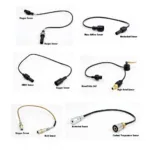If you’re a Pontiac Bonneville owner, seeing that dreaded Check Engine light illuminate on your dashboard can be frustrating. It’s a signal that your car’s onboard computer has detected a problem and is generating an OBD2 code. These codes act as a roadmap to understanding what’s wrong with your Bonneville. This guide is designed to help you understand those codes, what they mean, and how to get started on the path to fixing them.
What are OBD2 Codes and Why They Matter for Your Pontiac Bonneville?
OBD2 stands for On-Board Diagnostics, Generation 2. It’s a standardized system used in vehicles manufactured since 1996 to monitor emissions, engine performance, and other critical systems. When your Bonneville’s computer detects a problem, it stores a corresponding OBD2 code. These codes are alphanumeric and consist of a letter (indicating the system affected) and four numbers (specifying the problem).
Knowing how to interpret these codes empowers you to:
- Pinpoint the problem: Rather than guessing at the cause of an issue, OBD2 codes provide a more precise starting point for diagnosis.
- Save time and money: By having a better understanding of the problem, you can avoid unnecessary repairs and potentially save money on expensive diagnostic fees at a mechanic.
- Take proactive measures: Identifying issues early can prevent minor problems from escalating into major (and costly) repairs.
Common OBD2 Codes for Pontiac Bonneville
While countless OBD2 codes exist, some are more prevalent in Pontiac Bonnevilles. Let’s delve into a few examples:
P0171 – System Too Lean (Bank 1): This code suggests that the engine is running lean, meaning there’s an excess of air compared to fuel in the air-fuel mixture. This could be due to a vacuum leak, a faulty mass airflow sensor (MAF), or problems with the oxygen sensors.
P0420 – Catalyst System Efficiency Below Threshold (Bank 1): This code points to a problem with the catalytic converter’s efficiency in converting harmful exhaust gases into less harmful ones. Common causes include a faulty oxygen sensor, a damaged catalytic converter, or an exhaust leak.
P0300 – Random/Multiple Cylinder Misfire Detected: This code indicates that one or more cylinders in your Bonneville’s engine aren’t firing correctly. This could be caused by faulty spark plugs or wires, a bad ignition coil, a vacuum leak, or even problems with fuel delivery.
P0440 – Evaporative Emission Control System Malfunction: This code indicates a problem with the system responsible for preventing fuel vapors from escaping into the atmosphere. Potential culprits include a loose or damaged gas cap, a faulty purge or vent valve, or leaks in the EVAP system.
P0135 – O2 Sensor Heater Circuit Malfunction (Bank 1, Sensor 1): This code signifies an issue with the heating element in the upstream oxygen sensor, which helps the sensor heat up faster and provide accurate readings. A faulty sensor or wiring problems are often the cause.
How to Read OBD2 Codes on Your Pontiac Bonneville
To access the treasure trove of information stored within those OBD2 codes, you’ll need an OBD2 scanner. Here’s a step-by-step guide:
- Locate the OBD2 port: In most Pontiac Bonnevilles, you’ll find the port under the driver’s side dashboard, near the steering column.
- Connect the scanner: Insert the scanner’s connector into the OBD2 port.
- Turn the ignition to “On”: Don’t start the engine yet.
- Retrieve the codes: Follow the scanner’s instructions. Most scanners have a simple interface for reading and clearing codes.
Beyond the Code: Taking Action
Remember, an OBD2 code is a starting point, not a definitive diagnosis. If you’re uncomfortable tackling repairs yourself, consult a qualified mechanic. They can use their expertise, along with further diagnostic tests, to pinpoint the exact problem and recommend the best course of action.
FAQs: Your Pontiac Bonneville OBD2 Questions Answered
Q: Can I keep driving my Pontiac Bonneville with the Check Engine light on?
A: While you might be able to drive for a short distance, it’s crucial to address the issue promptly. Ignoring the Check Engine light could lead to further damage or reduced fuel efficiency.
Q: Do I need a special OBD2 scanner for my Pontiac Bonneville?
A: Most standard OBD2 scanners work with all OBD2-compliant vehicles, including your Bonneville.
Q: Can I clear the codes myself?
A: Yes, most OBD2 scanners allow you to clear codes. However, simply erasing the code doesn’t fix the underlying problem.
Q: My Check Engine light came back on after clearing the code. What does this mean?
A: This usually indicates that the problem persists. Further diagnosis is needed to determine the root cause.
Need More Help? OBDFree is Here for You
Diagnosing car problems can be daunting, but it doesn’t have to be. Armed with the knowledge of OBD2 codes, you can take control of your Pontiac Bonneville’s health. If you have any questions or need expert advice, don’t hesitate to reach out to our team at OBDFree. We’re here to help you keep your Bonneville running smoothly.
Contact us on WhatsApp: +1(641)206-8880, Email: [email protected]. Our customer support team is available 24/7 to assist you.


